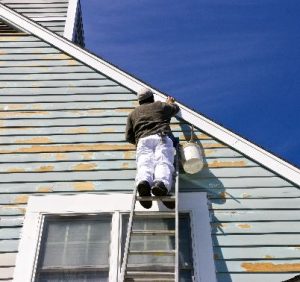
10 Steps to a Perfect Exterior Paint Job
Posted on February 18, 2021
 If you don’t have thousands of dollars to splurge on an exterior paint job for your home, there are ways to cut costs or do it yourself. If you choose the latter, here are the 10 Steps to a Perfect Exterior Paint Job for the Home DIY-er to ensure your success.
If you don’t have thousands of dollars to splurge on an exterior paint job for your home, there are ways to cut costs or do it yourself. If you choose the latter, here are the 10 Steps to a Perfect Exterior Paint Job for the Home DIY-er to ensure your success.
Siding, wood and other exterior surfaces can be refreshed with a new coat of paint. It also helps protect your home in inclement weather. If you do it right, a perfect exterior paint job can last up to 10 years and add value and curb appeal to your home. The key component is proper preparation.
Need help with a painting project? Contact us to set up a free estimate appointment.
1. Test
While you as a diy-er are not required to follow lead-safe practices, it’s important to know what you are dealing with. If your home was built before 1978 or you don’t know, you are at risk of having lead levels in your paint. Before any work begins, purchase a lead paint test kit. They are available online or in hardware stores.
If your home tests positive for paint, it’s not the end of the world. You will need to take extra precautions.
Use plastic drop cloths to collect scrapings.
Clean up with a HEPA vacuum.
Wear masks and invest in Tyvek suits.
Take any garbage to a hazardous materials site for disposal.
2. Wash
Avoid mildew infestations by cleaning the surface thoroughly with phosphate-free cleaner. Use a pressure washer to make short work of the job. This step is important because mildew thrives in dirty, grimy areas. By removing that, your new paint will adhere better.
3. Scrape
Wait until everything is dried, take a scraper and remove any loose or damaged pieces. Creating a flat surface is crucial. Hot-air guns or infrared paint strippers are available in some areas for rent or purchase. It will make the job faster but can add costs. Do not ever use an open-flame torch. It can easily turn a paint job into a fire. It’s also illegal in most states without a permit.
4. Sand
Use a pad-sander or random-orbit fitted with 80-grit sandpaper to smooth out any roughness. A delicate touch is important so you don’t leave sander marks in the wood. It’s recommended to use a sander with HEPA filter.
5. Repair
Inevitably, in your washing, scraping and sanding, you have uncovered a few holes, dings or chips. Use patching putty or compound to fill them in. Bigger issues may require the help of a carpenter to replace pieces of wood. It’s a good time to see if you can find any wood or rot, or water pooling that could cause it.
6. Prime
Use a tinted primer to create a perfect exterior paint job paint your house. The tint will help to highlight any areas that could use a layer of caulk to fill holes or gaps. This will create a tightly sealed and even surface for the top coat. If your house was previously painted in oil-based paint, you will need to apply oil-based on top of it.
7. Caulk
Now is the time to fill those joints and gaps with your caulk. If you don’t, you will see water and air leaks, both affecting the outcome of your paint.Look for caulk that touts a 55-year warranty. It will stand up to weather better. You may need several tubes to complete the house.
8. Shop
Choosing the right paint is half the battle in a paint job. There are a few characteristics to remember. Water-based acrylic paint is easier to work with for amateurs. Latex paint applies easily, dries fast, cleans with water and soap. But, if your home had oil-based paint before, it must be used again.
Pick your finish carefully too. The higher the shine content, the stronger the paint will be from the sun’s rays. Satin can work on shingles or clapboards, but high-gloss is best on high traffic portions of the house like handrails and door frames.
9. Apply
Don’t try to skimp on coats by adding more paint each time. The coats should be thin and allowed to dry completely between.
10. Maintain
You can extend the life of your perfect exterior paint job by taking care of it. Each year, replace any cracked or missing caulk. Remove mildew or mold. Wash stains. Touch up any imperfections as they appear.





